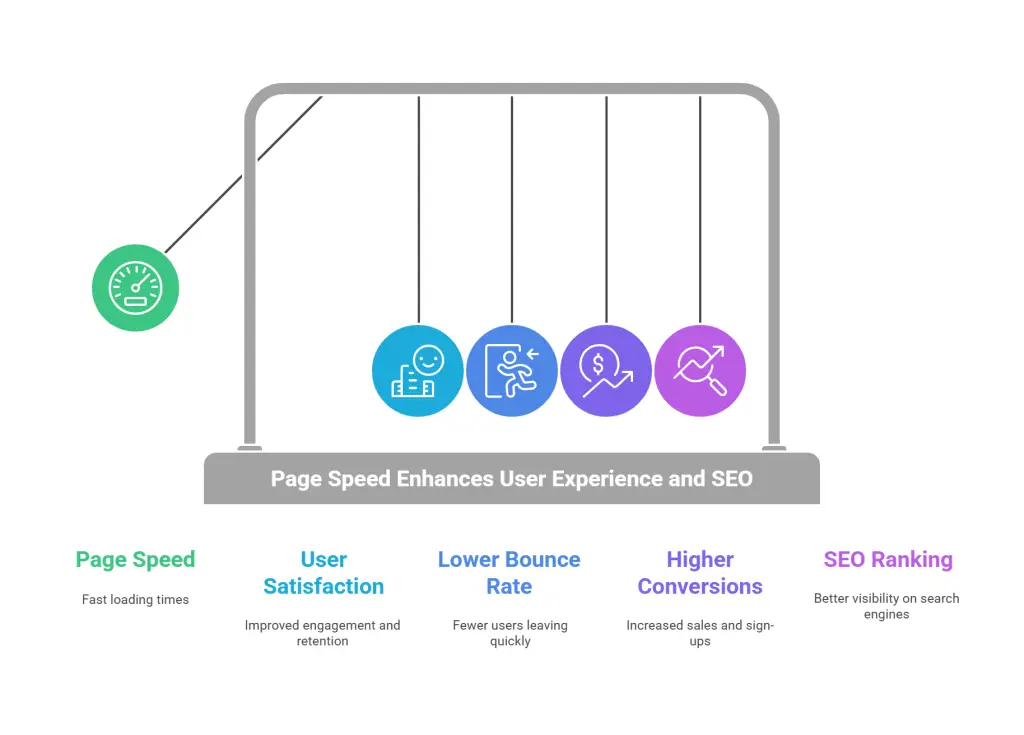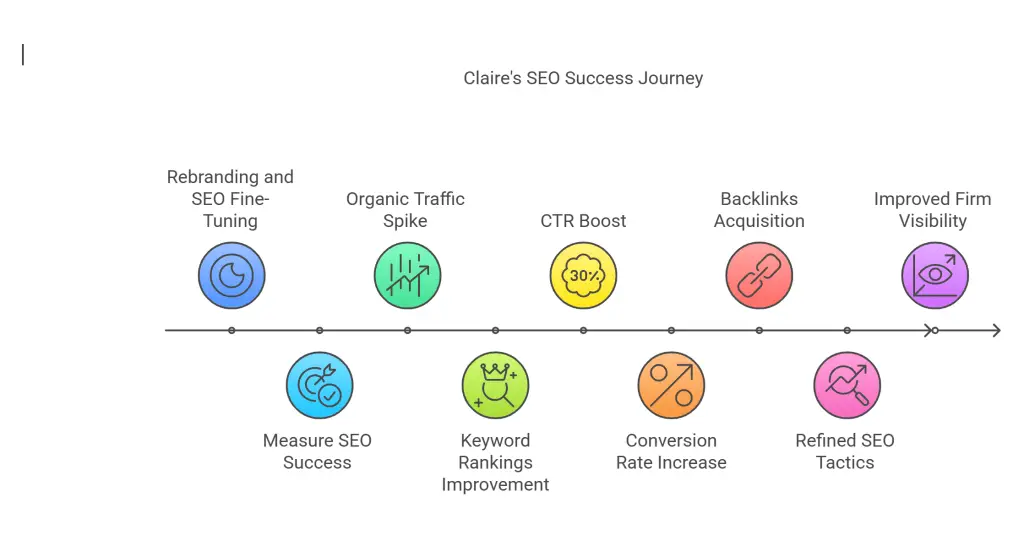Search Engine Optimization (SEO) is essential for enhancing your website’s visibility, driving more organic traffic, and converting visitors into leads or customers. However, success in SEO is more than just ranking high on search engine results pages (SERPs). To truly understand how well your SEO efforts are performing, you need to track them using specific Key Performance Indicators (KPIs).
Why Tracking SEO Success Matters
SEO is a long-term investment, but without a system for measuring results, it can be difficult to determine if the investment is paying off. Tracking the right KPIs gives you clarity on:
- Which SEO strategies are effective.
- Where there are gaps in your approach.
- How your website compares to competitors.
- Whether your efforts are translating into real business growth.
For small businesses, every marketing dollar counts. Therefore, having concrete data on SEO performance allows you to make informed decisions, ensuring that your SEO investments yield the best return.
Let’s now look into the critical KPIs that matter most when measuring SEO success.

Essential KPIs to Track for SEO Success
1. Organic Traffic
Organic traffic refers to visitors who land on your website through unpaid search results. It’s a direct measure of how well your website ranks and how visible your content is to searchers. For most businesses, organic traffic is the largest source of visitors and, over time, tends to be the most cost-effective channel compared to paid ads or social media.
Why It Matters:
- Organic traffic represents people who are actively searching for your products or services.
- Higher organic traffic means better search visibility and optimized keyword usage.
How to Measure It:
- Google Analytics: This tool allows you to track the amount of traffic coming from organic search versus other channels like paid search, direct traffic, or social media. By using the “Acquisition” tab, you can filter organic traffic to view trends.
- Third-Party SEO Tools: Tools like SEMrush, Ahrefs, or Moz allow you to monitor organic traffic growth, keyword performance, and how your site compares with competitors.
Tips to Improve Organic Traffic:
- Focus on Long-Tail Keywords: These are more specific phrases with lower search volume but higher conversion rates. They tend to be easier to rank for and bring in highly targeted traffic.
- Content Quality: Publish valuable, high-quality content that answers user queries. Use the “People also ask” section on Google for ideas to create relevant content.
- Internal Linking: Structure your website so that internal links lead visitors to related pages, keeping them engaged and improving SEO.

2. Keyword Rankings
Your keyword rankings show how well your site is performing in search engine results for specific terms. The higher you rank for targeted keywords, the more organic traffic you’re likely to receive. Ranking well for relevant keywords, especially those related to your products or services, is a clear sign of SEO success.
Why It Matters:
- Higher rankings increase the likelihood that users will click on your website in search results.
- Consistently high rankings for relevant terms are indicative of solid on-page and off-page SEO practices.
How to Measure It:
- Google Search Console: Track keyword performance directly from Google’s perspective. It provides insights into which search queries drive the most traffic.
- Ahrefs or SEMrush: These tools allow you to track your rankings for multiple keywords over time and give you a competitive analysis of how you compare to other sites.
Tips to Improve Keyword Rankings:
- Optimize for User Intent: Understand what users are searching for and optimize your content to answer their queries. Align your content with informational, navigational, or transactional intent based on your target keywords.
- Refresh Content: Periodically update older content to make it more relevant and SEO-friendly by adding recent data, better formatting, and additional keyword optimization.
- On-Page SEO: Ensure you are optimizing key elements such as title tags, meta descriptions, headings, alt text, and URL structure with your target keywords.

3. Click-Through Rate (CTR)
Click-through rate (CTR) measures the percentage of people who click on your website link after seeing it in search results. A high CTR means your meta titles and descriptions are effectively enticing people to click on your site over competitors.
Why It Matters:
- A high CTR boosts your ranking potential, as search engines may interpret your site as more relevant for that query.
- CTR helps bridge the gap between search visibility and actual website traffic. It’s not enough to simply rank; you need to entice users to click.
How to Measure It:
- Google Search Console: Provides reports on the average CTR for your site across different queries and pages.
- SEO Tools: Tools like Moz and Ahrefs also provide CTR insights to help you analyze how your keywords are performing in search results.
Tips to Improve CTR:
- Write Compelling Meta Descriptions: Meta descriptions should highlight the unique benefits of your page and include a clear call-to-action (CTA). A well-crafted meta description can increase CTR even if you’re not the top result.
- Use Rich Snippets: Implement structured data (schema markup) on your website to enable rich snippets like star ratings, product information, or FAQs, which can make your listing stand out.
- A/B Test Titles: Experiment with different title tags to see what resonates best with users. Incorporate keywords naturally while using action verbs or questions to generate interest.

4. Bounce Rate
Bounce rate refers to the percentage of visitors who leave your website after viewing only one page. A high bounce rate might signal that the content is not engaging or that the page isn’t delivering on the promise of what users were searching for.
Why It Matters:
- A high bounce rate can lead to lower rankings because it suggests to search engines that users are not finding what they need on your site.
- Reducing bounce rate can increase time on site and encourage users to explore more pages, which can lead to higher conversions.
How to Measure It:
- Google Analytics: Provides bounce rate data for each page, helping you identify underperforming pages and figure out how to reduce exits.
Tips to Improve Bounce Rate:
- Improve User Experience (UX): Simplify your website’s navigation, optimize page load times, and ensure your design is mobile-friendly.
- Relevant Content: Ensure that the content on each landing page aligns with the keywords users are searching for. If users don’t find what they expect, they’ll leave quickly.
- Engage Visitors with Internal Links: Provide clear internal links to related content that might interest the visitor, encouraging them to explore further instead of bouncing.

5. Conversion Rate
Conversion rate refers to the percentage of visitors who take a desired action on your website, such as purchasing a product, signing up for a newsletter, or filling out a contact form. SEO isn’t just about getting people to your site—it’s about getting the right people who will take action.
Why It Matters:
- A high conversion rate indicates that your site’s content is relevant and meets user expectations.
- Tracking conversions ensures you can measure the return on investment (ROI) of your SEO efforts.
How to Measure It:
- Google Analytics: Use the Goals feature to set up specific conversion actions such as purchases, form submissions, or downloads.
- Third-Party Tools: Platforms like HubSpot and Hotjar allow for detailed tracking of visitor behavior and conversions.
Tips to Improve Conversion Rate:
- Refine Your Call-to-Actions (CTAs): Make your CTAs clear, prominent, and easy to engage with. Test different wording or placements to see what works best.
- Optimize for Mobile: Ensure that your mobile site is fast and easy to navigate. Many users now complete conversions via mobile, and poor mobile performance can hurt conversion rates.
- A/B Testing: Experiment with landing page design, form fields, or product offerings to see what drives more conversions.

6. Backlinks and Referring Domains
Backlinks are links from other websites pointing to your site. They are one of the most important factors in Google’s ranking algorithm because they signal to search engines that your content is valuable and trustworthy.
Why It Matters:
- The number and quality of backlinks directly impact your website’s authority, leading to higher rankings.
- Backlinks from reputable sites drive referral traffic, increasing your site’s visibility and trust.
How to Measure It:
- Ahrefs, Moz, SEMrush: These SEO tools allow you to track the number of backlinks to your site, identify referring domains, and assess the quality of those links.
Tips to Improve Backlinks:
- Guest Posting: Reach out to authoritative blogs or websites in your industry and offer to write a guest post. In exchange, you get a backlink to your site.
- Create Shareable Content: Develop high-quality, original content such as infographics, whitepapers, or guides that others will want to link to.
- Engage in Influencer Outreach: Collaborate with influencers or industry leaders who can link to your content and boost your credibility.

7. Page Speed
Page speed measures how quickly your website loads. A fast website improves user experience and is favored by search engines. Google has confirmed that page speed is a ranking factor, and it also impacts bounce rate, user satisfaction, and conversion rates.
Why It Matters:
- Slow page speeds lead to higher bounce rates and lower conversions, especially on mobile.
- Page speed is part of Google’s Core Web Vitals, making it essential for SEO performance.
How to Measure It:
- Google PageSpeed Insights: Analyze your page load times and get actionable recommendations for improving speed.
- GTMetrix: Offers detailed reports on speed issues and performance bottlenecks.
Tips to Improve Page Speed:
- Compress Images: Use tools like TinyPNG to reduce image file sizes without sacrificing quality.
- Minimize Code: Reduce, minify, or compress CSS, JavaScript, and HTML to speed up your site’s loading time.
- Enable Browser Caching: Caching stores some elements of your website locally in users’ browsers, allowing for faster load times on repeat visits.

Advanced Tracking Techniques
While the above KPIs are foundational, taking your tracking efforts to the next level can provide deeper insights into your SEO performance. Advanced tracking techniques can help you understand the “why” behind your numbers.
1. Cohort Analysis
Cohort analysis breaks down user groups based on shared characteristics or behaviors. For example, tracking the behavior of users who visited your site after a specific SEO campaign can give insight into the long-term impact of your efforts.
How It Helps:
- Understand user behavior over time.
- Identify the campaigns or content pieces that drive long-term engagement.
2. Funnel Tracking
Funnel tracking helps you visualize the customer journey and pinpoint where users drop off before completing a desired action. By mapping out the steps users take, you can identify potential obstacles or issues in the conversion process.
How It Helps:
- Optimize landing pages or checkout processes.
- Increase conversion rates by identifying weak points in the funnel.
3. Heat Maps
Heat maps show where users are clicking, scrolling, and spending the most time on your site. This helps you understand user interaction, showing whether your CTAs are in the right place and if your content is engaging enough.
How It Helps:
- Optimize page layout for user engagement.
- Improve site usability by identifying problem areas.

Case Study: Claire’s Accounting Services

Claire runs a small accounting firm that caters to local businesses. After rebranding and fine-tuning her SEO approach, she needed to measure how these changes affected her online presence. Here’s how Claire tracked her SEO success:
Organic Traffic: Within six months, Claire saw a 60% spike in organic traffic, largely due to blog posts tailored to local tax and bookkeeping topics.
Keyword Rankings: Her firm secured top-three placements for relevant keywords such as “local accounting services” and “small business bookkeeping.”
CTR: By optimizing meta descriptions and implementing schema markup for rich snippets, Claire boosted her click-through rate by 25%.
Conversion Rate: After setting up funnel tracking, Claire noticed that her service pages underperformed in conversions. She revised the page copy and CTAs, leading to a 20% jump in conversion rates.
Backlinks: Claire’s guest posting on industry-related sites earned credible backlinks, lifting her domain authority and search engine positions.
Thanks to these insights, Claire refined her SEO tactics and improved her firm’s visibility, contributing to a steady rise in clientele and revenue.

Overcoming Common Challenges in Tracking SEO KPIs
Even with the right KPIs and tracking methods, you may still face challenges. Here’s how to overcome some of the most common issues:
1. Data Overload
It’s easy to feel overwhelmed by the volume of data available. To avoid data paralysis, focus on the KPIs that align with your business goals, and use them to guide your decision-making.
2. Time Lag in Results
SEO results don’t happen overnight. Patience is key. Track progress over weeks and months rather than days, and set realistic expectations for how quickly you’ll see changes.
3. Misinterpreting Data
Numbers don’t always tell the full story. For example, a high bounce rate might not be a bad thing if users are quickly finding what they need and leaving satisfied. Always consider the context of the data you’re analyzing.

Conclusion
Tracking SEO success requires a strategic approach to measuring KPIs like organic traffic, keyword rankings, CTR, conversion rates, and more. By regularly analyzing these metrics, you’ll gain insights into what’s working, what needs improvement, and how to maximize your ROI.
Remember, SEO is a long-term game, but with consistent tracking and optimization, you can ensure that your efforts lead to meaningful growth for your business.
Next Steps:
- Begin by setting clear SEO goals.
- Identify the KPIs most relevant to your business.
- Monitor your data regularly and adjust your strategy based on performance insights.
Frequently Asked Questions
What is organic traffic, and why is it important for SEO?
Organic traffic refers to visitors who arrive at your website through unpaid search results. It’s a direct measure of your site’s visibility and effectiveness in attracting users actively searching for your products or services.
How can I improve my website’s organic traffic?
To boost organic traffic, focus on long-tail keywords, publish high-quality content that addresses user queries, and implement internal linking to guide visitors to related pages, enhancing engagement and SEO performance.
Why are keyword rankings significant in measuring SEO success?
Keyword rankings indicate how well your site performs in search engine results for specific terms. Higher rankings for relevant keywords increase the likelihood of attracting organic traffic and reflect effective SEO practices.
What tools can I use to monitor keyword rankings?
Tools like Google Search Console, Ahrefs, and SEMrush allow you to track keyword performance over time, providing insights into which search queries drive the most traffic and how you compare to competitors.
How does focusing on user intent improve keyword rankings?
Optimizing content to align with user intent ensures that your website effectively answers search queries, leading to higher keyword rankings and increased organic traffic.
Further reading
DashThis. “SEO Tracking: The Definitive Guide to Measuring & Monitoring SEO Success.” DashThis Blog, January 10, 2024. https://dashthis.com/blog/seo-tracking/. (Accessed March 8, 2025).
Quora. “How Can I Track the Effectiveness of My SEO Efforts?” Quora, last modified March 8, 2025. https://www.quora.com/How-can-I-track-the-effectiveness-of-my-SEO-efforts. (Accessed March 8, 2025).
Ahrefs. “SEO Metrics That Actually Matter.” YouTube, uploaded February 21, 2023. https://www.youtube.com/watch?v=2RLkqx9C-N4. (Accessed March 8, 2025).
SEMrush. “How to Track SEO Performance in 2023.” YouTube, uploaded January 18, 2023. https://www.youtube.com/watch?v=nzvLZmCQQf4. (Accessed March 8, 2025).
Neil Patel. “How to Measure Your SEO Success.” YouTube, uploaded March 10, 2023. https://www.youtube.com/watch?v=rDxKxWi7mXM. (Accessed March 8, 2025).







